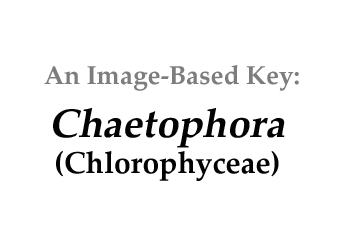|
Home / Greens / Filamentous / Branched / Chaetophora |
||||
|
|
||||
|
Click
on images for larger format |
||||
Name derivation: |
||||
Classification:
|
||||
Chaetophora Schrank 1783;
7 of 31 species descriptions are currently accepted taxonomically (Guiry and Guiry 2014).
|
||||
Morphology: |
||||
|
Branching green trichomes with one parietal
"wrap-around", "napkin-ring" chloroplast per cell.
Cross-walls are flat, providing maximal contact between adjacent cells.
Motile stages produced from peripheral cells, zoospores quadriflagellate and gametes
biflagellate and isogamous. Asexual
reproduction occurs through quadriflagellate
zoospores. During the process of settlement, zoospores loose the flagella and
become rounded. Attachment involves the fixation of zoospores by means of an
adhesion disk made up of a mucilage. Germlings acquire then a spindle-like shape. Zoospore
germination is erect, the first unilateral branches
are formed. After a month of development, an erect system made up of radially arranged filaments is occurs. Zoospores may
germinate in groups resulting in a compound thallus. Chaetophoraceae are taxonomically diverse and have many species with colorless hairs. It has been noted in a number of studies that hair development depends largely of the concentrations of nitrate where the culture is growing, and has been more common in low concentrated areas (Gibson, M, 2007). |
||||
Wastewater mitigation: |
||||
|
Chaetophora, among
other species was found to variable amounts of heavy metals, phosphorous and
ammonium from artificial wastewaters. After 10 days incubation in the wastewaters,
the algae removed 74% Pb, 76% of Ni, 70% of Zn, and
75% of Fe, among other elements. Chaetophora has the potential to be used for the uptake of
heavy metals, metal detoxification and numerous environmental cleanup
projects (Salam, A. 2015). |
||||
Similar genera: |
||||
|
Stigeoclonium has less frequent branching; Rhizoclonium
still less branching. |
||||
Hair Formation:
|
||||
|
Eleven strains of Stigeoclonium tenue Kütz. and one of Chaetophora
incrassata (Hudson) Hazen were subjected to
deficiencies of Mg, Ca, Fe, N, P and S. The responses between strains
differed, but in general the greatest amount of hair formation was brought
about by P deficiency, with N deficiency having almost as great an effect (Whitton etal. 2007) |
||||
Habitat: |
||||
|
Freshwater. |
||||
References: |
||||
|
Gibson, M.,
Whitten B. 2007. Hairs, phosphate activity and environmental chemistry in Stigeoclonium, chaetophora and
Draparnaldia.
British Phycological Journal. 11-22. Salam A.,
Shah Z., Ullah, K., Khan I., Khan F., Ahmad N.,
Khan K.2014. Effect of pH and Temperature on the effects of Indigenous Algae
to Remove Contaminants from Artificial Wastewaters. IOSR Journal of Agriculture
and Veterinary Science7 (3):62-72. Schrank, F. von P. 1783.
Botanische Rhapsodien. Der Naturforscher (Halle) 19:
116-126. Whitton, B.A., and J.P.C. Harding 2007. Influence of nutrient deficiency on hair formation
in Stigeoclonium."
European Journal of Phycology 31(1): 65-68. |
||||
















